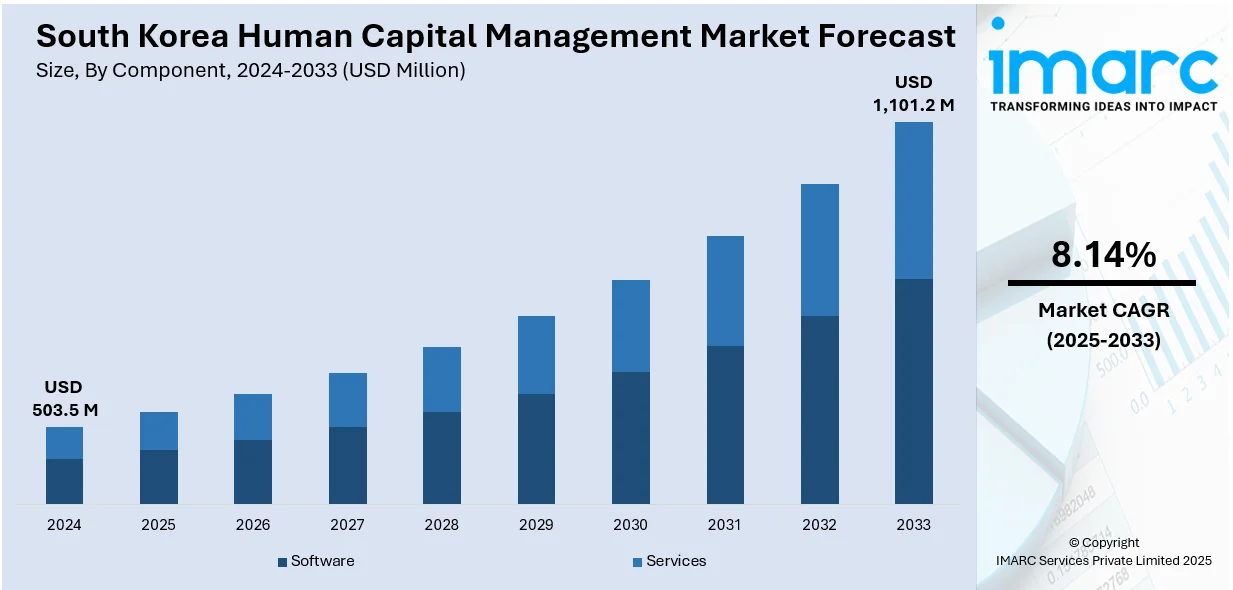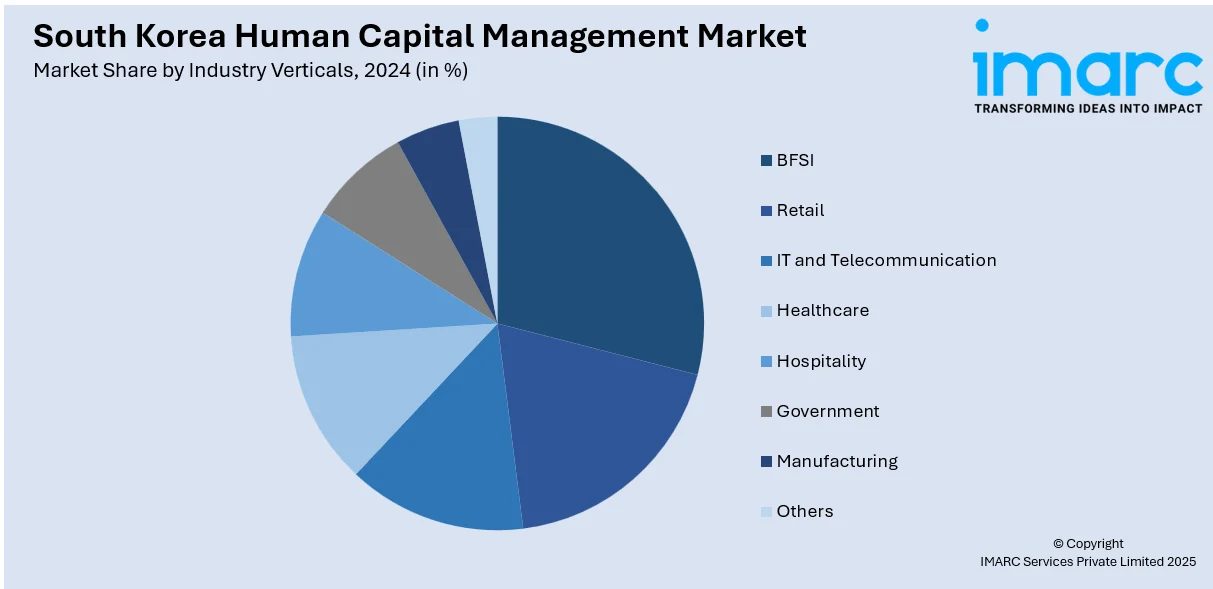
South Korea Human Capital Management Market Size, Share, Trends and Forecast by Component, Deployment Type, Industry Verticals, and Region, 2025-2033
South Korea Human Capital Management Market Overview:
The South Korea human capital management market size reached USD 503.5 Million in 2024. The market is projected to reach USD 1,101.2 Million by 2033, exhibiting a growth rate (CAGR) of 8.14% during 2025-2033. The market is expanding due to rising demand for digital workforce tools and integrated HR platforms. In addition, growing emphasis on employee well-being and automation of HR tasks continues to support South Korea human capital management market share across large enterprises and mid-sized firms.
|
Report Attribute
|
Key Statistics
|
|---|---|
|
Base Year
|
2024
|
|
Forecast Years
|
2025-2033
|
|
Historical Years
|
2019-2024
|
| Market Size in 2024 | USD 503.5 Million |
| Market Forecast in 2033 | USD 1,101.2 Million |
| Market Growth Rate 2025-2033 | 8.14% |
South Korea Human Capital Management Market Trends:
Shift Toward Cloud-Based Solutions
The South Korea human capital management market growth is increasingly shaped by the widespread adoption of cloud technologies. organizations are turning to cloud-based platforms to manage payroll, recruitment, performance tracking, and workforce analytics with greater flexibility and cost-efficiency. These systems reduce the need for on-site infrastructure and allow for real-time data access across departments. SMEs, in particular, are driving this change due to their preference for scalable solutions that can grow with their workforce. As remote and hybrid work models continue to solidify, the need for centralized and accessible HCM tools is rising. Cloud platforms also simplify compliance with labor regulations and tax codes, which are becoming more complex. In the past two years, several local vendors have expanded their offerings, integrating AI capabilities to automate resume screening, employee engagement tracking, and training needs assessments. This shift is not just about cost-saving it reflects a broader emphasis on agility and data-backed decision-making in HR departments.

To get more information on this market, Request Sample
Increased Focus on Employee Experience
South Korean companies are placing more value on employee satisfaction and engagement, and this trend is reshaping their HCM priorities. HR leaders are adopting systems that support personalized career development, mental health programs, and feedback-driven management. With a tightening labor market and a declining working-age population, companies are competing to attract and retain top talent by offering better work-life balance and learning opportunities. Tools that offer continuous performance tracking, anonymous feedback channels, and internal mobility mapping are gaining ground. Newer HCM platforms are being selected for their ability to track employee sentiment and analyze turnover risks. Over the past year, major Korean conglomerates have begun using predictive analytics to understand what drives employee departures and how to intervene early. This data-driven focus is helping companies move away from rigid annual appraisals toward more adaptive and personalized HR strategies. Enhancing employee experience is no longer optional, it is fast becoming a central pillar of talent strategy.
South Korea Human Capital Management Market Segmentation:
IMARC Group provides an analysis of the key trends in each segment of the market, along with forecasts at the country and regional level for 2025-2033. Our report has categorized the market based on component, deployment type, and industry verticals.
Component Insights:
- Software
- Core HR
- Recruiting
- Workforce Management
- Compensation and Payroll
- Others
- Services
- Managed Services
- Professional Services
The report has provided a detailed breakup and analysis of the market based on the component. This includes software (core HR, recruiting, workforce management, compensation and payroll, and others) and services (managed services and professional services).
Deployment Type Insights:
- Cloud-based
- On-premises
The report has provided a detailed breakup and analysis of the market based on the deployment type. This includes cloud-based and on-premises.
Industry Verticals Insights:

- BFSI
- Retail
- IT and Telecommunication
- Healthcare
- Hospitality
- Government
- Manufacturing
- Others
The report has provided a detailed breakup and analysis of the market based on the industry verticals. This includes BFSI, retail, IT and telecommunication, healthcare, hospitality, government, manufacturing, and others.
Regional Insights:
- Seoul Capital Area
- Yeongnam (Southeastern Region)
- Honam (Southwestern Region)
- Hoseo (Central Region)
- Others
The report has also provided a comprehensive analysis of all the major regional markets, which include Seoul Capital Area, Yeongnam (Southeastern Region), Honam (Southwestern Region), Hoseo (Central Region), and others.
Competitive Landscape:
The market research report has also provided a comprehensive analysis of the competitive landscape. Competitive analysis such as market structure, key player positioning, top winning strategies, competitive dashboard, and company evaluation quadrant has been covered in the report. Also, detailed profiles of all major companies have been provided.
South Korea Human Capital Management Market News:
- June 2025: South Korea advanced its human capital management industry with the introduction of a draft law mandating corporate human rights and environmental due diligence. This strengthened accountability for workforce conditions and ethical practices, driving demand for compliance-based HR systems and responsible business conduct solutions.
South Korea Human Capital Management Market Report Coverage:
| Report Features | Details |
|---|---|
| Base Year of the Analysis | 2024 |
| Historical Period | 2019-2024 |
| Forecast Period | 2025-2033 |
| Units | Million USD |
| Scope of the Report |
Exploration of Historical Trends and Market Outlook, Industry Catalysts and Challenges, Segment-Wise Historical and Future Market Assessment:
|
| Components Covered |
|
| Deployment Types Covered | Cloud-based, On-premises |
| Industry Verticals Covered | BFSI, Retail, IT and Telecommunication, Healthcare, Hospitality, Government, Manufacturing, Others |
| Regions Covered | Seoul Capital Area, Yeongnam (Southeastern Region), Honam (Southwestern Region), Hoseo (Central Region), Others |
| Customization Scope | 10% Free Customization |
| Post-Sale Analyst Support | 10-12 Weeks |
| Delivery Format | PDF and Excel through Email (We can also provide the editable version of the report in PPT/Word format on special request) |
Key Questions Answered in This Report:
- How has the South Korea human capital management market performed so far and how will it perform in the coming years?
- What is the breakup of the South Korea human capital management market on the basis of component?
- What is the breakup of the South Korea human capital management market on the basis of deployment type?
- What is the breakup of the South Korea human capital management market on the basis of industry verticals?
- What is the breakup of the South Korea human capital management market on the basis of region?
- What are the various stages in the value chain of the South Korea human capital management market?
- What are the key driving factors and challenges in the South Korea human capital management market?
- What is the structure of the South Korea human capital management market and who are the key players?
- What is the degree of competition in the South Korea human capital management market?
Key Benefits for Stakeholders:
- IMARC’s industry report offers a comprehensive quantitative analysis of various market segments, historical and current market trends, market forecasts, and dynamics of the South Korea human capital management market from 2019-2033.
- The research report provides the latest information on the market drivers, challenges, and opportunities in the South Korea human capital management market.
- Porter's Five Forces analysis assists stakeholders in assessing the impact of new entrants, competitive rivalry, supplier power, buyer power, and the threat of substitution. It helps stakeholders to analyze the level of competition within the South Korea human capital management industry and its attractiveness.
- Competitive landscape allows stakeholders to understand their competitive component and provides an insight into the current positions of key players in the market.
Need more help?
- Speak to our experienced analysts for insights on the current market scenarios.
- Include additional segments and countries to customize the report as per your requirement.
- Gain an unparalleled competitive advantage in your domain by understanding how to utilize the report and positively impacting your operations and revenue.
- For further assistance, please connect with our analysts.
 Request Customization
Request Customization
 Speak to an Analyst
Speak to an Analyst
 Request Brochure
Request Brochure
 Inquire Before Buying
Inquire Before Buying




.webp)




.webp)












